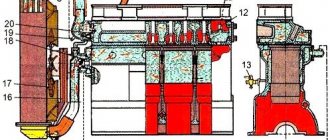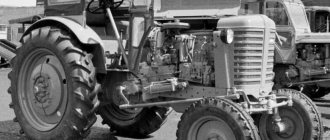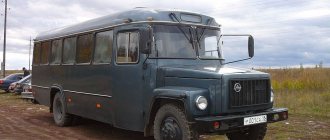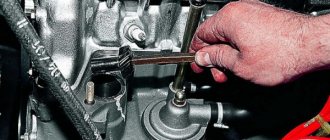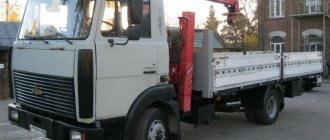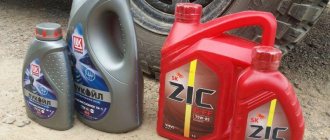T-40 is a wheeled tractor designed for use in the agricultural and road sectors. Traction class 0.9.
Manufacturer: Lipetsk Tractor Plant. Release period: 1961-1995. The tractors are now out of production, but are still in use. The reasons for the long service life are the durability of the design, versatility and optimal conditions for repair: all spare parts are available.
General characteristics of the T-40
Purpose:
- plowing;
- processing of field crops;
- mowing;
- hay harvesting, baling;
- snow clearing;
- bulldozer and transport work.
Operational features:
- high cross-country ability;
- good maneuverability (thanks to the reverse transmission, all the functionality of the machine is available in reverse);
- adjustable track and clearance;
- two power take-off shafts;
- Various options for installing wheels depending on the specific purpose.
Performed work and equipment
T-40 is effectively used on:
When performing work, the tractor was equipped with additional equipment. At the same time, the positive features include the addition of equipment from the smaller T-30, and from the load-lifting MTZ-80.
Two PTOs give the tractor versatility: rear and side. Commonly used mounted and trailed equipment for joint work include:
Despite the amount of attachment for the T-40, when used on heavy soils, there was a lack of productive equipment. This applied to specialized plows and cutters.
The T-30 equipment models are low-performing, while the MTZ-80 is heavy on productivity. Therefore, machine operators often remade plows from Belarus 80 and T-74, with subsequent adjustments.
The manufactured cutters increased productivity the most, as they combined devices: a cultivator, a baron, and sometimes a plow.
To carry out the loading and unloading operations necessary in winter to clear roads of snow at the entrance to farms and complexes, machine operators installed a homemade front-end loader (KUN) on a T-40 tractor.
A bucket mounted on the rear linkage, using a hydraulic cylinder, performed the functions of a bulldozer and loading equipment, which allows the T-40 to be used with KUN all year round.
Advantages and disadvantages of the T-40 tractor
Pros:
- High cross-country ability on any soil.
- Ease of maneuvering at any speed.
- All tractor functionality is available in reverse.
- Ease of control.
- Versatility: the ability to be equipped with attachments for other types of machines (T-25, “Belarus”).
- No problems with spare parts and maintenance.
- Reliability, durability.
- The steering of the tractor is equipped with power steering.
T-40 tractor with attachments
Cons
The main disadvantage of the tractor is the air cooling of the engine. Because of this, operational difficulties arise:
- Cooling is not effective enough in hot weather.
- It is difficult to warm up the engine before starting it in winter.
- Lack of heating and air conditioning in the driver's cabin, which makes work in hot and cold conditions uncomfortable.
Technical characteristics of the T40 tractor
To understand what kind of oil to pour into the T40 tractor, you need to study the technical part of this model. The machine is designed to perform agricultural land works, use in construction and loading and unloading operations. In addition to the general markings, the tractor is available in two modifications - T40M and T40AM. It is also equipped with two types of engines: D144 and D37.
To decide which oil is suitable for the T40 tractor, it is necessary to take into account the features of the power unit, transmission and hydraulics. If we are talking about the first models of the car, then they were equipped with D37 diesel engines, later versions were equipped with a D144 diesel engine. Both engines are similar in parameters: they are 4-cylinder, 4-stroke, air-cooled power units. The motors are equipped with removable cylinders, which are located in one row with heat transfer fins.
Main parameters of motors installed on T40:
- mixture formation by injection of working fluid;
- power parameters: 37 or 50 hp or 27.2 and 36.8 kW, respectively;
- crankshaft performance: 1400-1800 rpm;
- camera operating principle: 1-3-4-2;
- declared volume: 4.15 l;
- specific fuel consumption: 239-341 g/kW*h.
The machine works with two types of transmission: mechanical and reverse. Equipped with a 4-way transmission with 8 speeds and locking and reverse functions.
Hydraulic complex:
- hydromechanical amplifier;
- 4-position hydraulic valve;
- equipped with a gear pump;
- hydraulic tank for amplifier;
- three-point mechanism for attachments.
To ensure that all systems function properly, synthetic and semi-synthetic complexes are selected for the T40, which actively replace the mineral compounds used in the first models of this machine.
Modifications
With D-37 engine
The base model has rear-wheel drive. Its modifications are made with all-wheel drive:
- T-40A – presence of a front axle. Front-wheel drive engages automatically in accordance with driving conditions;
- T-40AN - the tractor is adapted for working on a steep slope, the height and ground clearance are less than the basic version;
- T-50A is an industrial modification, adapted for a single-bucket loader.
With D-144 engine
The T-40M has rear-wheel drive, while the modifications have all-wheel drive:
- T-40AM - unlike the T-40M - front axle with drive;
- T-40ANM - a powerful analogue of the T-40AN: reduced ground clearance for working on a steep slope (up to 20 degrees), lower height, greater stability;
- T-40AP is an industrial model, adapted for working with road equipment.
User manual
Every owner of a T-40 tractor or anyone who plans to buy it should be familiar with the operating instructions. If the paper copy is lost somewhere, you can find an electronic version of the operating instructions on the forums. Your browser does not support frames
Maintenance
To extend the service life of the T-40 tractor, it is necessary to carry out maintenance in accordance with the requirements of the operating instructions. The tractor must be cleaned of any remaining dirt and dust at the end of each trip. This will help prevent corrosion on the device elements.
Oil M-10G2k Oil M-10V2 STOU oil OilTAD-17i
Adjustment of valves
The gas distribution mechanism of the T-40 tractor engine from time to time needs to be checked and the most precise adjustment of the valves, which is usually performed not as a repair, but as an operating procedure by the machine operator himself.
According to technical rules, such an adjustment must take place every 480 hours of tractor operation (that is, at least every 20 days). The T-40 engine has a standard 4 valves - two exhaust and two intake to introduce fresh air into the cylinders, release exhaust gases and protect the combustion chamber. For D-36, D-37 engines they have plates of different diameters - the exhaust plates are 4 mm smaller. The valves are actuated by the lateral force of the rocker arms on their stems. It is in adjusting the size of the gap between the rocker arms and the valve stems, as well as in ensuring the tightest fit of the valves to the seats, that the adjustment of this mechanism lies:
- If the clearance between the valves and the rocker arm is too small, then unwanted gas leakage may occur,
- If this distance is large, this can cause knocking and rapid wear of parts.
- The drive pulley sets the position of the piston of the first engine cylinder to the final compression position until the intake and exhaust valves close.
- The rear universal joint wedge is removed. This can be done by moving the shaft while turning the steering wheel towards you, then the cardan can be easily moved to the side.
- The locknut at the rocker arm adjusting screw is loosened.
- The gap size is checked with a special probe. Ideally, with a cold engine it should be exactly 0.3 mm.
- The size of the gap is adjusted by changing the degree of tightening of the screw (tightening it more or loosening it).
- The value is checked again using a probe.
- If the control data is satisfactory, the locknut is installed back and tightened.
Multi-purpose oil options
So, to answer the question of how you can pour oil for a T-40 tractor into the engine, it’s worth considering popular options. Universal fluids are suitable for equipment, which lubricate the engine and other components and elements of the device.
Many people believe that it is better to use a separate type of oil for each system, namely motor, hydraulic, transmission. And this entails large expenses, and it is not always possible to find lubricants of the same brand. But now there are universal compounds on sale that are suitable for all components of the machinery mechanism. They are suitable for hydraulics and transmissions. They also provide complete lubrication of diesel engine parts.
There are 3 classes of universal liquids:
- TDTO (Transmission & Drivetrain Oil). Tractors are suitable for gearboxes and hydraulic systems. They have excellent practicality and stable viscosity. The composition contains antifriction and extreme pressure additives.
UTTO (Universal Tractor Transmission Oil). Designed for hydromechanical transmission. They have a good foundation and retain performance for a long time.
STOU (Super Tractor Oil Universal). Suitable for hydraulic systems, transmissions and internal combustion engines. The composition contains a complex combination of additives and detergents.
Which is better - synthetic or mineral?
Previously, mineral fluids were used to lubricate the main components of internal combustion engines. But gradually they began to be used less often. This is due to the fact that synthetics and semi-synthetics have appeared on the market. These options have the best performance properties and do not lose their basic properties for a long time.
Mineral options are made from crude oil, and at elevated temperatures or under pressure it begins to lose its original properties. This means that after a certain period of time the lubricant ceases to perform its functions and this negatively affects the main parts of the equipment and leads to rapid wear.
Synthetic options are being improved and used in various internal combustion engines - from jet engines to tractor diesel engines. The main advantage is that they do not contain components that cannot withstand high temperatures. When using lubricants, no sediment appears, and no oxidative deposits form on the surfaces of parts.
Why is oil needed?
The choice of composition determines the wear resistance of the mechanisms and the uninterrupted operation of the power unit. The use of oil and its timely replacement are necessary for:
- reducing friction of parts;
- increasing shear resistance;
- increasing thermal stability;
- protection against shock absorption;
- preventing metal corrosion.
The use of oils allows you to extend the service life of the main components of equipment, clutches, and hydraulics, which in turn reduces maintenance costs.
During operation, the liquid spreads to the main components:
- piston rings;
- sleeves;
- pump drive;
- camshaft cams.
Oil circulation is possible only when the engine is turned on, which means that the durability and performance of the power unit depends on the quality of the working fluid.
For gasoline and diesel engines
The T-40 is equipped with gasoline and diesel engines, and special oils should be used for them. The most suitable option would be all-season lubrication; it is considered universal.
The container is usually marked M-6з/10В and is manufactured in compliance with the requirements of GOST 10541-78. The base has many additives and additional components that retain the lubricating properties of the substance for a long time.
If a diesel engine is installed, but there is no turbocharging, then it is worth purchasing G2k fluid. Oils are divided into viscosity classes from 8 to 10, and class 14 is also commercially available.
M-10G2 or M14G2 are popular on the market. They are based on additives and additional components that prolong the operation of lubricating properties. Tests have shown that the products have low ash content. With proper operation of the equipment, if functioning properly, they can work for 300 hours.
